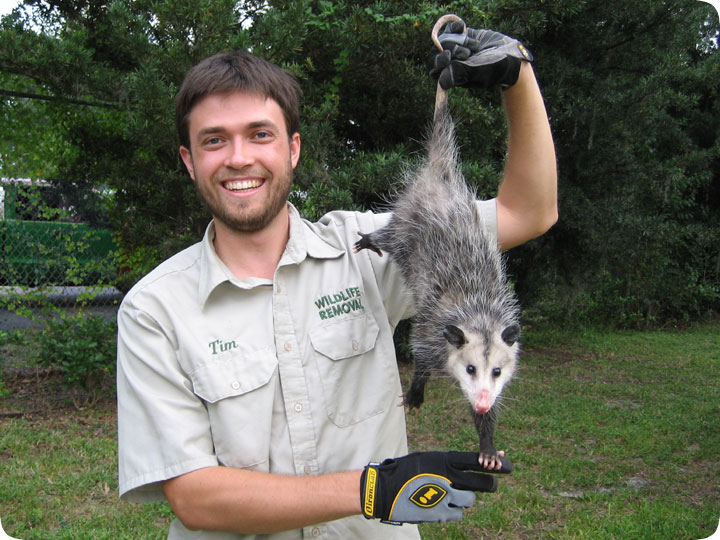-
info@aaanimalcontrol.com
Call us for help in your town
Humane Wildlife Education
Critter Catcher in Training

09.09.2006 - Ah, yet another disgruntled software engineer who's decided to take a walk on the wild side. I myself used to be a software developer, hating my life
behind the desk staring at a computer screen (oh wait, that's what I'm doing at this very moment), but when I discovered the fun of working outside catching critters, I haven't
looked back. My friend Tim decided that he'd like to do the same thing, so now he's down here with me in Florida, training to be a critter catcher himself. He wants
to open his own operation in Portland after six months or so with me.
Tim is about the most agreeable person I could hope to work with. He's extremely helpful and
polite, and he never messes up. He's got a lot of common sense and he's a good learner and hard worker. He also doesn't mind getting his hands wet with the
wildlife. Take this opossum for example. Right after this photo it peed all over his glove, but he didn't mind a bit.
If you want to be a good critter
catcher, you've got to have more than a knowledge of wildlife. You've got to know building architecture, construction, ladder safety, and more importantly, how to deal
with people. Yes, you do have to deal with wildlife, but in the field of human-wildlife conflicts, there's the humans to deal with as well, and many of them are a good
deal stranger than the critters, that's for sure. Tim here is great with both, and I'm glad to have him here.
We specialize in nuisance wildlife control - this is the field of removing unwanted wildlife from homes and property, and solving conflicts between people and wild animals. From home inspections to preventative repairs, wildlife trapping, attic cleanups and more, we solve
critter problems with professional expertise. Call me, David, or click on the below link to find any one of hundreds of wildlife trappers in every city and town in the US.
Do it yourself: Visit my How To Get a Wildlife Removal Job page for tips and advice.
Get professional help: Visit my Nationwide Pro Directory of wildlife removal experts.
For more wildlife stories, click my Wildlife Blog
or click my below banner to hire a local trapper.
Wild animals visiting our properties is not a new thing anymore. It is not a good idea to make wild animals into pets. But they can't be left wandering freely on one's property either. As some of them can prove to be a nuisance often. The best strategy in the situation is a DIY plan to scare the animal away or call a professional critter catcher in to take away the animal. Injuring or killing an animal is not advised at any cost.
Wildlife removal services are available everywhere especially in the areas where there are frequent visits by the uninvited guests. But this profession has soared to popularity in recent times. More people are training to be wildlife removal professionals.
Training required to become a wildlife removal professional
There are training programs offered for those who want to become a wildlife removal professional. When the training is complete, you become a professional who can not only get rid of nuisance pests on your own property, but can also extend services to others as a properly trained professional. You need to be knowledgeable of the following terms and procedures in order to be equipped with the necessary skills:
- Wildlife damage management – principles and rules
- Complete knowledge of wildlife diseases
- Control methods for wildlife
- Physical safety
- Method of site inspection
- Methods of wildlife control
- Techniques of animal handling
- How to dispose of carcasses
- Legalities
- Ethical rules
- Trapping
- Toxicants
- Business practices
- Exclusion
- Detailed information of wildlife species
The process to become a wildlife removal professional
After gaining knowledge on what you need to be trained on as a professional, you must be aware of the process it takes to become a wildlife removal professional. There is no rocket science involved. If you have a passion for this profession or you want to do it as a hobby, you have to follow a few steps. We will take you through a roadmap of the process with us below:
- Enroll yourself in a competent training program.
- You will have to complete on the job training to get hands-on practice under the supervision of your mentor.
- After you have completed the training program, you become a certified wildlife removal professional.
- Next you must obtain a license to work as a specialist.
- For getting a license, you must take a written exam.
- Find a job via online job portals or your training school.
- Renew your permit on a yearly basis.
Final verdict
It is very important to understand the nature of wildlife animals thoroughly in order to deal with them once you become a professional wildlife remover. Always try your best to use humane methods and encourage others to as well. All you need to do is keep your senses intact and decide the best course of action that is least harmful to both animals and humans.




















